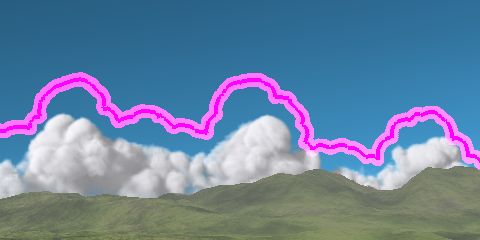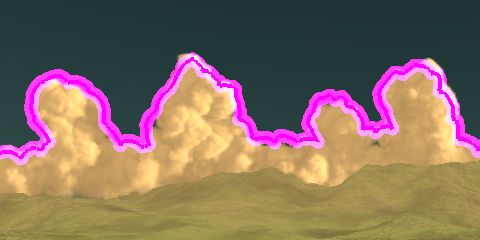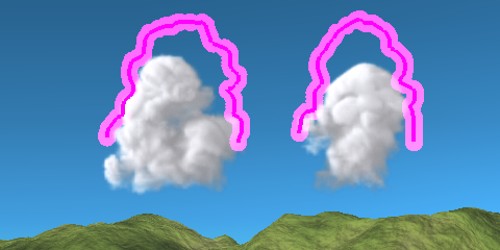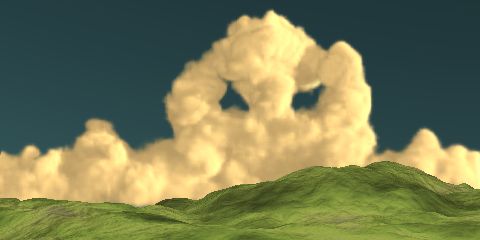Feedback Control of Cumuliform Cloud Formation based on
Computational Fluid Dynamics
ACM Transaction on Graphics (Proceedings of SIGGRAPH 2008), Vol. 27, No. 3 , Article 94
Yoshinori Dobashi1,
Katsutoshi Kusumoto1,
Tomoyuki Nishita2,
Tsuyoshi Yamamoto1
1Hokkaido University,
2The University of Tokyo

Abstract
Clouds play an important role for creating realistic images of
outdoor scenes.
In order to generate realistic clouds, many methods have been
developed for modeling and animating clouds.
One of the most effective approaches for synthesizing realistic
clouds is to simulate cloud formation processes based on the atmospheric
fluid dynamics.
Although this approach can create realistic clouds, the
resulting shapes and motion depend on many simulation parameters and the
initial status.
Therefore, it is very difficult to adjust those parameters so
that the clouds form the desired shapes.
This paper addresses this problem and presents a method for
controlling the simulation of cloud formation.
In this paper, we focus on controlling cumuliform cloud
formation.
The user specifies the overall shape of the clouds.
Then, our method automatically adjusts parameters during the
simulation in order to generate clouds forming the specified shape.
Our method can generate realistic clouds while their shapes
closely match to the desired shape.
Download
Videos

|
|
This animation corresponds to Figure 1 in the paper.
The desired shape is relatively simple.
In this case, the target shape is the height field.
The shape of the clouds generated by our method is almost the same as the desired shape.
|
|
Video 1. Simple example
|
|
|---|

|
|
This animation corresponds to Figure 7 in the paper.
We specify a more characteristic shape.
In this case, the target shape is not the height field.
However, our method can generate clouds that closely match the desired shape.
Since the clouds are generated in three-dimensions, we can render the clouds
with arbitrary viewpoints and illumination as shown in this movie.
|
|
Video 2. Complex example
|
|
|---|


|
|
For comparison, we implemented the method proposed by Fattal et al [2004] and combined with the cloud simulation.
The left animation shows the result using the previous method.
The right animation shows the result using our method.
When using the previous methods, clouds are generated where they should not be.
This is because the previous method do not take into account the cloud formation process.
Our method can generate realistic-looking clouds.
These examples correspond to Figure 6 in the paper.
|
|
Video 3. Comparisons with the previous method [Fattal et al. 2004]
|
|
|---|

|
|
This animation shows an unnatural shape of clouds, the shape of a skull.
In this case, the target shape is completely different from the height field.
Although there are differences between the simulated clouds and the desired shape,
our method succeeded in creating the convincing result. This animation corresponds to Figure 8(a).
|
|
Video 4. Unnatural shape of clouds
|
|
|---|

|
|
This animation shows a failure case.
In this case, the rightmost part of the clouds does not match the target shape.
This animation corresponds to Figure 8(b).
|
|
Video 5. A failure case
|
|
|---|

|
|
This animation corresponds to Figure 9 in the paper.
We generate clouds that resemble the real clouds in a photograph.
The contour line of the real clouds is extracted.
Then this contour line is used to control the simulation by our method.
|
|
Video 6. Clouds from photograph
|
|
|---|

|
|
The following animation shows the 360 view around the clouds shown in Figure 7 in the paper.
This animation has been created to examine the shape of clouds viewed from various viewing directions.
Although the shape tends to become the sweep of the contour line specified by the user,
clouds are realistic even for the viewpoints other than the viewpoint used for specifying the desired shape.
|
|
Video 7. 360 view around clouds
|
|
|---|

|
|
Fluid dynamics simulations on 3D grids have the well-known issue of behaving differently depending on
the resolution of the grid. The following animation has been created to investigate the effect of
the resolution on our control method. This animation is the low-resolution version of the simulation
shown in Figure 1 in the paper. The simulation conditions are the same as those of Figure 1, except
the number of grid points, that is 160x40x50. Our method succeeded in creating the convincing result
even for this low-resolution simulation.
|
|
Video 8. Low resolution clouds
|
Citation
@article{doba2008,
author = {Yoshinori Dobashi and Katsutoshi Kusumoto and Tomoyuki Nishita and Tsuyoshi Yamamoto},
title = {Feedback Control of Cumuliform Cloud Formation based on Computational Fluid Dynamics},
journal = {ACM Transactions on Graphics (Proceedings of SIGGRAPH 2008)},
year = {2008},
volume = {27},
number = {3},
articleno = {94}
}
Acknowledgement
We thank the SIGGRAPH reviewers for their constructive comments;
Dr. Ken Anjyo for valuable discussions.
This research is partly supported by the Strategic Information and Communications R&D
Promotion Programme (SCOPE) from the Ministry of Internal Affairs and Communications of Japan.











